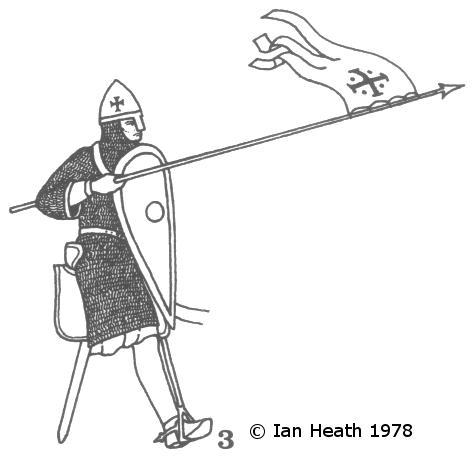FRANKISH KNIGHT c. 1097An extract from Armies and Enemies of the Crusades 1096-1291by Ian Heath [Based on A painted window in the monastery church of St Denis in Paris] 
|
FRANKISH KNIGHT c. 1097An extract from Armies and Enemies of the Crusades 1096-1291by Ian Heath [Based on A painted window in the monastery church of St Denis in Paris] 
|
3. FRANKISH KNIGHT c. 1097
The development of armour in the crusader states followed exactly the same course as in Europe. Since this has already been discussed in ‘Armies of Feudal Europe’ it is not intended to cover the subject in detail again and the following 6 figures should be taken only as a representative selection.
It is generally accepted, quite rightly, that knights of the First Crusade and, to a lesser extent, the Second Crusade would have been little different from the Norman knights depicted in the Bayeux Tapestry, and this conclusion is borne out by this figure who, though he dates to the mid-12th century, represents a knight of the First Crusade. He carries a kite-shield, wears a conical helmet (with or without nasal) and a knee-length, ¾-sleeved hauberk, and is armed with lance and sword.
He carries the crusader device on helmet and gonfalon and could also have had it painted on his shield. An English knight of the First Crusade is described as having crosses on his helmet, shield, saddle and horse accoutrements, and certainly during the earlier crusades knights carried the cross device chiefly on shield and/or helmet. Shields were otherwise painted in bright colours and patterns, many probably resembling Bayeux Tapestry types; Albert of Aix, describing crusaders at Antioch in 1097, speaks of ‘shields of gold, green, red and other colours.’
At what stage crusaders who stayed on in the Holy Land gave up wearing the cross is an unanswerable question. Apparently some never did, though it seems probable that the majority of settlers did so soon after fulfilling their pilgrim’s vows.